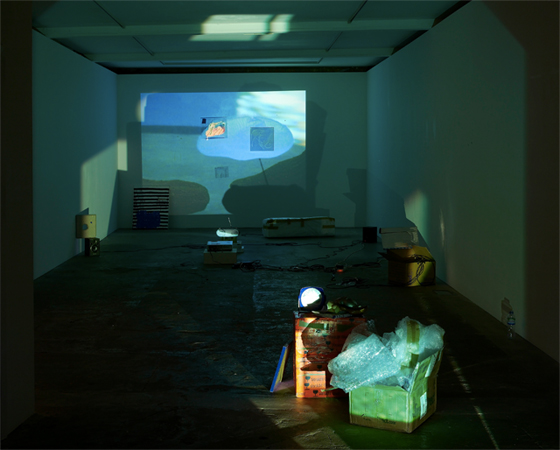As with Madonna y El Nino, Trisha Baga‘s’ most recent exhibition Rock at Vilma Gold employs tangential narratives. Within them environmental change and pop music echo the increasingly fragmented logic of Internet culture.
The fact that Baga’s video installations initially look cheap and slightly haphazard is a clever device for getting you with your guard down. Grounded in materiality and process, there are no clear edges to this work and upon entering the space it’s hard to know where to walk. The gallery itself appears more like a workspace where during installation, the artist, using whatever items are at hand, neglects to discard those that aren’t needed. Small lumps of Blu-tack remain on the wall and extension cords lie on the floor unplugged. It feels transient and without intention.

The deliberateness of these objects only becomes apparent over time and happens so unexpectedly that they are fantastical moments. A box stuffed with packing plastic casts a ghostly shadow of a huddled figure, which is only revealed when the video projection recedes into darkness. A round desktop mirror sitting atop this box is the head. When a second projector goes, the mirror bounces distorted imagery across the wall, while the plastics glow and refract coloured light throughout the room. These simple, makeshift phenomena feel as though they might have been stumbled across while Baga was playing in her home. There’s the sensibility of youthful experimentation to this artist’s work belying its sophistication and resourcefulness.
The first video ‘Plymouth Rock’ illuminates a whole wall at the far end of the gallery, across which float neon jellyfish and shaky hand-held footage of tourist attractions. The artist has then re-shot the footage, overlaid with daubs of paint, moving geometric shapes and glimpses of her own body. A soundtrack of badly dubbed pop is then often then confounded by a voice coming from behind the camera. The second video ‘Hard Rock’ was shot in the synthetic landscape of a penguin enclosure while being serviced by a cleaner. Both works interrogate leisure and heritage, where associated ephemera expire so quickly they too become relics; souvenirs and home made holiday movies, void of nostalgia, simply look out-dated. It is this inherent disposability, resulting from Baga’s intervention, that becomes the most interesting by-product of the once-special moments. Visually, comparisons could be drawn from the low budget techniques of Arte Povera coupled with the neo-psychedelic palate of 80s music videos.
Literally meaning ‘poor art’, Arte Povera was borne out of the radical social and political upheaval of the 60s. The movement saw artists explore shifts in power and the disintegration of high culture through the use of everyday materials. It seems fitting that this kind of subversive approach is currently being re-imagined in galleries all over East London, where less than a year ago, some of the most volatile riots broke out. Though not directly responsive to this political unrest, Baga’s work is concerned with the self in relation to systems of social order at a time of accelerated change. **













